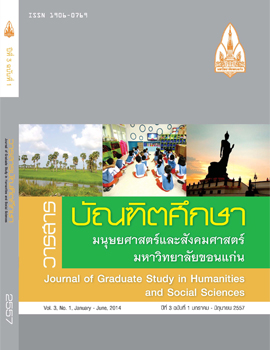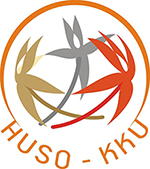การพัฒนารูปแบบการจัดการขยะมูลฝอยของชุมชนในเขตเทศบาลนครอุดรธานี
Keywords:
การพัฒนารูปแบบการจัดการขยะมูลฝอย, การมีส่วนร่วม, The Development Model Management Solid Waste, ParticipationAbstract
การวิจัยนี้มีวัตถุประสงค์เพื่อ 1) สำรวจความคิดเห็นเพื่อยืนยันตัวบ่งชี้การจัดการขยะมูลฝอย ใช้แบบสอบถามจำนวนกลุ่มตัวอย่าง รวม 306 ตัวอย่าง 2) สร้างรูปแบบโดยใช้สารสนเทศจากขั้นที่ 1 ตรวจสอบความเหมาะสมและความเป็นไปได้ของรูปแบบโดยผู้ทรงคุณวุฒิ 14 คน 3) ทดลองใช้รูป แบบ 1 ชุมชน และ 4) ประเมินรูปแบบโดยกลุ่มทดลองใช้ ค่าเฉลี่ยส่วนเบี่ยงเบนมาตรฐาน มัธยฐานค่าพิสัยระหว่างควอไทล์ Mann Whitney U-Test, t-test ในการวิเคราะห์ข้อมูล ผลการศึกษาพบว่า 1) ตัวบ่งชี้ต่อการจัดการขยะมูลฝอยของชุมชน ประกอบด้วย 4 องค์ประกอบ 15 ตัวแปร ดังนี้ องค์ประกอบที่ 1 คือ ความรู้ความเข้าใจ (know) ตัวชี้วัดได้แก่ (1) ประเภทขยะ(2) การคัดแยกขยะ (3) นำกลับขยะมาใช้ประโยชน์และ (4) การกำจัดขยะ องค์ประกอบที่ 2 คือ หลักการ 3 Rs ตัวชี้วัด ได้แก่ (1) การลดใช้ (Reduce) (2) การใช้ซ้ำ (Reuse) และ (3)การนำกลับมาใช้ใหม่ (Recycle) องค์ประกอบที่ 3 คือ การมีส่วนร่วม (Par) ตัวชี้วัดได้แก่ (1) ค้นหาสาเหตุ (2) วางแผน (3) ดำเนินการ (4) ประเมิน องค์ประกอบที่ 4 คือ บริบทชุมชน (Context) ตัวชี้วัดได้แก่ (1) ลักษณะที่ตั้งของชุมชน (2) จำนวนประชากรในชุมชน (3) สภาพเศรษฐกิจของชุมชน (4) ผู้นำชุมชน 2) รูปแบบการจัดการขยะมูลฝอยของชุมชนและบริบทเบื้องต้นของชุมชนได้แก่ (1) สภาพปัจจุบัน ปัญหาและความต้องการของชุมชน (2) เทศบัญญัติ/กฎหมายนโยบายด้านการจัดขยะมูลฝอยของภาครัฐกรมควบคุมมลพิษ สำนักงานสิ่งแวดล้อมภาค 9 เทศบาลและชุมชน (3) ผลการทดลองใช้รูปแบบการจัดการขยะมูลฝอยของชุมชนผ่านการประเมินจากสำนักงานสิ่งแวดล้อมภาคที่ 9 และ (4) ผลการประเมินรูปแบบการจัดการขยะมูลฝอย พบว่า ในภาพรวมอยู่ในระดับมาก และพิจารณาเป็นรายด้านอยู่ในระดับมากทุกด้าน
The Development Model Management Solid Waste of Community in Udon Thani Municipality
The purposes of research were: 1) Opinion survey regarding waste management conditions was conducted to confirmatory indicators by using a questionnaire. The samples were 306 people 2) Setting the management solid waste of community model using data from the first step to be evaluated for the appropriateness and possibility of the model by 14 experts. 3) Implementing the management solid waste of community model a community. 4) Assessing the implementation of the management solid waste of community model by users. The statistics used for data analyzing were means, standard deviation, median, interquartile range, Mann-whitney U test, t-test.The results of research were as follows.: 1)Indicators the management solid waste of community included: 4 indicators 15 Variable. Factor 1, Know: (1) Kinds waste (2) Separate Waste (3) Recyclable waste (4) Disposal wastes. Factor2, 3 Rs: (1) Reduce (2) Reuse (3) Recycle. Factor3, Par: (1) Decision (2) Plan (3) Cooperation (4) Evaluate. Factor 4 Context: (1) Location (2) Population (3) Economic Situations (4) Leader 2)The management solid waste of community model and context backgrounds: (1) Current community problems and needs (2) Ordinance/ Municipal law, waste management policies of the government, Pollution Control Department, Regional Environmental Office 9, the Municipality, and the community; and 3) The results of implementing the management solid waste of community model in Udon Thani Municipality were as follows : The assessment rating by Regional Environmental Office 9. 4) The results of the management solid waste of community model in Udon Thani Municipality evaluated by the participants were at the high level. When considering each aspect, it was found that they were at the high level for all aspects.







